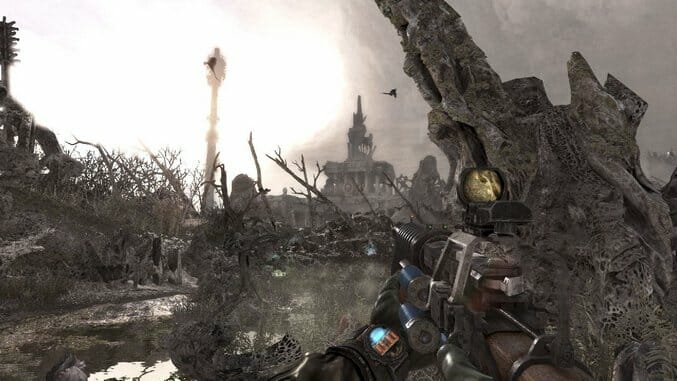Metro: Last Light (Multi-Platform)

It’s tough to pin down why Dmitry Glukhovsky’s Metro universe is so popular. His 2005 novel, Metro 2033, has spawned two sequels and some 33(!) spin-off novels to date. It also inspired 4A Games’ 2010 first-person shooter of the same name, a flawed but occasionally brilliant trip through the post-nuclear wasteland of underground Moscow. Glukhovsky’s universe is an irradiated hellhole populated by mutants, Communists and Nazis, where pathetic bands of survivors barely cling to life, if not hope. Leave it to a Russian to make this level of bleakness compelling.
Still, it’s fertile ground for a video game franchise, where atmosphere often trumps plausibility. 4A’s new offering, Metro: Last Light, is a sequel that improves upon the original in significant ways, and yet it retains several of the elements that made the original an occasionally maddening experience.
Last Light picks up the story of Artyom, the protagonist from Metro 2033. As Glukhovsky explained to me at PAX East, Last Light assumes the “bad” ending of 2033—that Artyom launched the missiles that destroyed the Dark Ones, supernatural beings that may have been humanity’s allies all along. A war is brewing in the Metro over control of D6, a well-provisioned government bunker that Artyom’s Rangers (the paladins of the Metro universe) inhabit. As the story begins, Artyom sets out from D6 to find the last surviving Dark One. He’s been ordered to kill it, but he makes it clear to us that own quest is about redemption. There’s been enough death in the Metro.
This theme is carried out throughout the story, which is surprisingly coherent, given the many leaps of logic Glukhovsky’s world asks us to make. Artyom is accompanied much of the time by one of several AI companions, a technique that allows 4A to develop characters while moving the plot along. The story, which Glukhovsky worked closely with 4A to develop, sags in the middle after a solid opening, but regains steam by the end. It is a linear, authored tale, but like the first game, there appears to be a hidden “karma” system affected by your choices. It’s unlikely that those who haven’t played or read Metro 2033 will fully grok Last Light, but familiarity with the world is certainly a plus. As a bonus, players who have read the novel will recognize some conversations lifted nearly verbatim from the book.
Last Light’s pacing is similar to 2033’s in that bouts of stealth and shooting are punctuated by periods of calm in the ramshackle towns of Metro stations. Like its predecessor, Last Light is strongest when it gives us these moments of incidental storytelling; eavesdropping on ancillary characters’ conversations is often more rewarding than slaying waves of beasts. At times, this (and the many scripted events where control is taken away from the player) gives the game a theme park ride-like feel, somewhat like Bioshock Infinite. Still, characters are rendered with remarkable fidelity, with dozens of custom animations for characters we see only once. At one point I witnessed a tangential conversation between one-off characters go on for more than five minutes. This humanizing effect grounds the sci-fi premise in an oddly believable and endearing way.
The same effect is accomplished with the returning gas mask and ammo-currency mechanics. As in the original, going topside requires keeping your mask on, making scrounging for filters essential. There’s even a dedicated button for wiping condensation (or blood) off the mask; I made frequent use of it. Bullets are money in the Metro, and while Last Light has a much more forgiving economy than 2033 (ammo is less scarce, and non-lethal takedowns make it less essential), the conceit is just as effective a storytelling device. It feels bizarrely natural to hand a beggar a few cartridges—or toss a few into a stripper’s tip jar. (Indeed, the least believable thing about Last Light is that the women of the subway tunnels are so universally ravishing.)
Level design in Last Light is generally better than in 2033, with more ways to navigate around enemies—although some spaces still feel more like puzzles to be solved than arenas of possibility. Taking the redemption theme to heart, I adopted a mostly non-lethal approach, preferring to sneak up on enemies and knock them out, Batman-style. Since there are no ranged non-lethal weapons, there’s a nice counting coup-type challenge in this approach. While you can successfully defeat human enemies by firing away, it’s much more satisfying to avoid doing so—especially since it’s easy to get overwhelmed once the shooting starts. The additions of an indicator on Artyom’s watch that lights up when you’re exposed and of a sound cue when you’re about to be spotted make playing Last Light as a stealth game a much more pleasant experience than it was in 2033.
